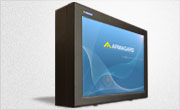Implementing Digital Signage Step-by-step
Posted by: Richard Williams | Posted on: | 0 Comments
With so much talk about the benefits of digital signage, more and more businesses are looking to this new out of home advertising media as a cost effective method of promoting and marketing their company.
However, digital signage like many other modern technologies does require some technical thought for its implementation which is often off putting to would be installers. But a digital signage campaign needn’t be difficult or complicated to install.
The requirements for any digital signage campaign are quite simple and can be broken down into five different parts:
Location
Screens
Delivery Method
Content
Protection
The type and size of screen required often depends on the location and type of content that is going to be displayed, for instance an outdoor digital signage screen would need to be larger than something at say a point of sale in a store.
The TV screen itself doesn’t need to be anything special. A standard LCD TV is perfectly adequate for digital signage and while HD technology is around at the moment it is often overspend to include high definition content for a digital signage campaign.
The delivery method for a digital advertising sign will depend on the number of signs you are planning on displaying. With multiple signs it is best to network them and with WiFi this can be done without the need for cables.
With a networked system the digital signage content can be uploaded to a single media player and distributed across all screens, although it must be noted that networking, even in its simplest form does require some past experience.
For single digital signs or to keep things simple, individual media players can be installed inside the digital signage enclosure by the screen. These can be as complicated or as simple as you like, from a thin client PC to a simple MP4 player.
Content is perhaps the key to any successful digital signage campaign which is understandable as everything that we are discussing is centred on the delivery of this content. Content can be made easily yourself using many simple software applications or you cold invest in a professional advertising company who will have the experience and skills to generate really attractive content for you.
Protection is also crucial for a digital signage screen. Don’t forget the TV device being used to display tour content will have been designed to operate inside a warm living room. Whilst outdoor digital signage is obviously going to need protecting from the weather indoor systems to be enclosed in protective LCD enclosure too to ensure that dust and other elements are kept out. Constant temperature and adequate airflow also need to be installed inside the LCD enclosure which itself should also act as protection from impacts or tampering.
Post shortlink:
Popular Products
LCD Enclosure
Need armor for your LCD/LED screen(s)? Outdoors or inside the versatile LCD enclosure protects against thieves, vandals & the weather. Installation idea: NFL stadiums.
Outdoor Digital Signage
Exclusive 46” outdoor screen protection. Dubbed the ‘Totem’, due to its distinct design, it repels damage threats, but attracts audiences. Installation idea: Drive-thru restaurants.
Portrait Flat Panel Enclosure
Safeguard your eye-level advertising display screen(s), indoors or outdoors. Completely customizable, add exciting features like touch screen technology. Installation idea: Restaurant frontages.
Indoor Digital Signage
Popular purchase for retail outlets! Great for ‘point of sale’ persuasion, boost your brand with static & motion advertising from a single unit! Installation idea: Mall of America.




